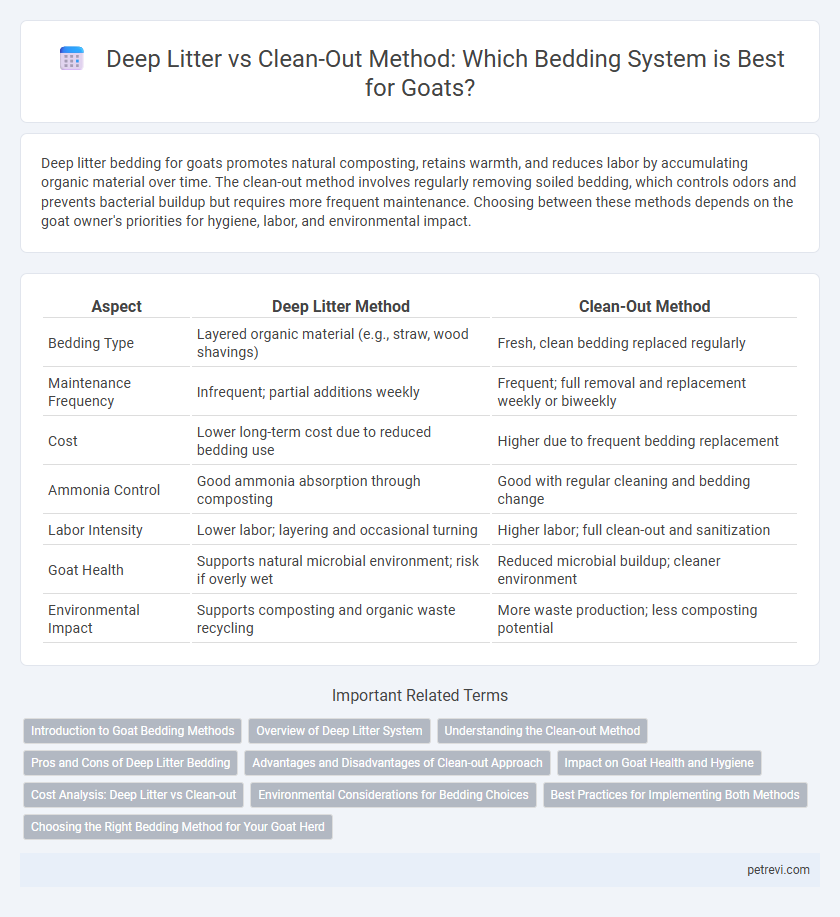Deep litter bedding for goats promotes natural composting, retains warmth, and reduces labor by accumulating organic material over time. The clean-out method involves regularly removing soiled bedding, which controls odors and prevents bacterial buildup but requires more frequent maintenance. Choosing between these methods depends on the goat owner's priorities for hygiene, labor, and environmental impact.
Table of Comparison
| Aspect | Deep Litter Method | Clean-Out Method |
|---|---|---|
| Bedding Type | Layered organic material (e.g., straw, wood shavings) | Fresh, clean bedding replaced regularly |
| Maintenance Frequency | Infrequent; partial additions weekly | Frequent; full removal and replacement weekly or biweekly |
| Cost | Lower long-term cost due to reduced bedding use | Higher due to frequent bedding replacement |
| Ammonia Control | Good ammonia absorption through composting | Good with regular cleaning and bedding change |
| Labor Intensity | Lower labor; layering and occasional turning | Higher labor; full clean-out and sanitization |
| Goat Health | Supports natural microbial environment; risk if overly wet | Reduced microbial buildup; cleaner environment |
| Environmental Impact | Supports composting and organic waste recycling | More waste production; less composting potential |
Introduction to Goat Bedding Methods
Goat bedding methods significantly impact animal health, comfort, and hygiene, with deep litter and clean-out systems being the most common. The deep litter method involves layering organic materials such as straw or wood shavings that decompose over time, creating a natural composting effect that controls odor and moisture. The clean-out method requires regular removal and replacement of bedding to maintain cleanliness, reducing ammonia buildup and minimizing parasite risks.
Overview of Deep Litter System
The Deep Litter System for goat bedding involves layering organic materials like straw, wood shavings, and manure over time, allowing natural decomposition to generate heat and reduce odors. This method improves insulation, providing a warm and comfortable environment that promotes goat health and reduces the need for frequent cleaning. Proper management of moisture and aeration is essential to maintain the system's effectiveness and prevent pathogen buildup.
Understanding the Clean-out Method
The clean-out method for goat bedding involves regularly removing all soiled material to maintain a fresh and hygienic environment, reducing the risk of disease and parasites. This practice requires consistent effort but offers better control over moisture and odor compared to the deep litter method. Proper application of the clean-out method enhances goat health by minimizing ammonia buildup and promoting cleaner living conditions.
Pros and Cons of Deep Litter Bedding
Deep litter bedding for goats offers superior insulation and natural composting, reducing waste removal frequency and promoting a healthier environment through beneficial microbial activity. However, it requires careful management to prevent ammonia buildup and potential respiratory issues, as accumulated waste can create odor and hygiene challenges. This method is cost-effective over time but demands regular monitoring to maintain optimal moisture levels and prevent bedding compaction.
Advantages and Disadvantages of Clean-out Approach
The clean-out method for goat bedding involves completely removing soiled material at regular intervals, promoting a hygienic environment that reduces parasite infestations and respiratory diseases. This approach provides better odor control and prevents ammonia buildup but requires more labor and increased bedding material costs compared to the deep litter system. Frequent disturbance of bedding can stress goats, and improper timing of clean-outs may lead to fluctuations in temperature and moisture affecting goat comfort.
Impact on Goat Health and Hygiene
The deep litter method for goat bedding promotes beneficial microbial activity that helps break down waste, reducing ammonia levels and supporting healthier respiratory systems. In contrast, the clean-out method requires frequent bedding replacement, which minimizes pathogen buildup but may increase stress due to disruption of the goats' environment. Proper management of both methods directly influences goat hygiene by controlling moisture and microbial balance, crucial for preventing hoof infections and respiratory diseases.
Cost Analysis: Deep Litter vs Clean-out
Deep litter bedding for goats typically reduces annual costs by recycling manure and bedding, minimizing the need for frequent replacement and disposal expenses. In contrast, the clean-out method incurs higher labor and material costs due to regular removal and complete bedding replacement, which can strain budgets in large-scale operations. Evaluating long-term cost efficiency, deep litter method offers significant savings through reduced waste management and continuous bedding use.
Environmental Considerations for Bedding Choices
The deep litter method for goat bedding promotes natural decomposition, reducing waste and enhancing soil fertility through nutrient recycling, which supports sustainable farming practices. In contrast, the clean-out method requires frequent removal and disposal of bedding, potentially increasing environmental impact due to waste management challenges and higher resource consumption. Selecting the appropriate bedding method influences manure handling, ammonia emissions, and overall environmental footprint in goat husbandry.
Best Practices for Implementing Both Methods
Deep litter method requires layering fresh bedding material regularly to maintain moisture control and promote beneficial microbial activity, enhancing goat comfort and manure management. Clean-out method involves thoroughly removing all soiled bedding and waste between uses, ensuring a hygienic environment and reducing parasite risks in goat housing. Both methods demand consistent monitoring of bedding moisture and cleanliness to optimize goat health and welfare effectively.
Choosing the Right Bedding Method for Your Goat Herd
Choosing the right bedding method for your goat herd depends on factors such as climate, herd size, and maintenance capacity. Deep litter bedding uses layers of organic material that decompose over time, providing insulation and natural compost, ideal for colder climates and larger herds. Clean-out bedding requires frequent replacement, promoting better hygiene and disease control, which suits smaller herds or warmer, humid environments where moisture buildup is a concern.
Deep litter vs Clean-out method for Goat bedding Infographic

 petrevi.com
petrevi.com